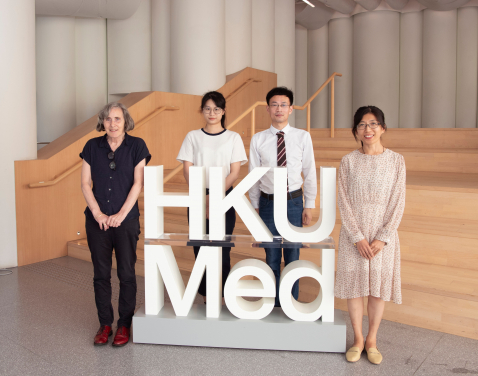Media
HKUMed finds high red meat consumption likely to increase the risk of cardiovascular disease and diabetes,
in a systematic review of more than 4.4 million people
in a meta-analysis
09 Oct 2023
A research team from the School of Public Health in LKS Faculty of Medicine, of The University of Hong Kong (HKUMed), reviewed large-scale meta-data covering more than 4.4 million people, and concluded that red meat consumption is associated with a higher risk of cardiovascular disease (CVD) and type 2 diabetes. For example, a 50 g/day increment of processed red meat consumption is related to a 26% higher risk of CVD and a 44% higher risk of type 2 diabetes (Appendix A). The harm was less obvious in Eastern settings, which have a higher intake of whole grains and vegetables and a lower red meat intake than in Western settings, with a higher intake of red meat and lower intake of vegetables and whole grains. The findings were published in a top peer-reviewed cardiovascular journal, the European Heart Journal [link to the publication].
Background
CVD is the leading cause of mortality globally. Type 2 diabetes is a common comorbidity of, and an established risk factor for, CVD. As a common part of the diet, red meat is gaining increasing attention for both individual and global health. However, previous studies did not reach consistent conclusions owing to relatively small sample sizes. Also, previous studies did not examine the potential differences in cultural settings, with different dietary habits. Therefore, this systematic review and meta-analysis were conducted to summarise the evidence concerning the association of red meat consumption with CVD and type 2 diabetes.
Research method and findings
After a comprehensive search of four databases (PubMed, Web of Science, Embase, and Cochrane Library), the researchers included 43 observational studies for CVD with 4,462,810 participants, and 23 studies for type 2 diabetes with 1,738,672 participants. Using the unit of a 100 g/day increment of unprocessed red meat and a 50 g/day increment of processed red meat, the study found that higher consumption of red meat, both processed and unprocessed, resulted in a higher risk of CVD and type 2 diabetes (Appendices A and B). The team also compared the risk in Western and Eastern settings. In Western settings, the diet is characterised by a higher intake of processed red meat, butter, high-fat dairy products and refined grains. In Eastern settings, in contrast, the diet is characterised by a higher intake of whole grains, vegetables and seafood.1 In an analysis of 25 studies conducted in Western settings, including the US, Australia, the UK, France and Germany, and five studies conducted in Eastern settings, including China, Japan, West Africa, South Korea and Singapore, the researchers examined the data by 50 g/day increments of processed red meat and 100 g/day increments of unprocessed red meat.2 the study found that the hazard ratio of type 2 diabetes risk of consuming processed red meat is 0.96 in Eastern settings and 1.51 in Western settings (Appendix C); and the hazard ratio of stroke risk of consuming unprocessed red meat is 0.71 in Eastern settings and 1.13 in Western settings (Appendix C). This shows a lower risk of stroke and type 2 diabetes in Eastern settings than in Western settings. The research team considered the Eastern dietary culture, with more vegetables and seafood and less red meat, to be the key difference in the settings.
Significance of the study
This systematic review and meta-analysis, with by far the largest sample size to date, was led by Dr Jane Zhao Jie from the School of Public Health of HKUMed. Although unprocessed red meat seems to have lower risk than processed meat, the research team found that 100 g/day of unprocessed red meat is still related to an 11% higher risk of CVD and 27% higher risk of type 2 diabetes (Appendix B). The study provides an alarm that red meat consumption should be limited for cardiometabolic and planetary health reasons.
The World Health Organization has classified processed meat as a Group 1 carcinogen for humans and red meat as Group 2A, probably carcinogenic to humans, which means both types of meat could harm human health.3 The research team considered the implications for Hong Kong, which is influenced by Western dietary culture, with frequent intake of processed meat, butter and refined grains. Dr Jane Zhao commented, ‘Meat imports in Hong Kong continue to rise, reflecting growing meat consumption in Hong Kong. If Hong Kong people continue to increase meat consumption, we may see a similar situation to what we see in the US, Europe and Australia, with an increased risk of cardiovascular disease and type 2 diabetes.’
About the research team
The research was led by Dr Jane Zhao Jie, Assistant Professor, School of Public Health, HKUMed. Members of the research team included PhD candidates Shi Wenming and Huang Xin, and Dr Mary Schooling, Honorary Associate Professor at School of Public Health, HKUMed, and Professor in the CUNY Graduate School of Public Health and Health Policy, City University of New York.
Acknowledgement
The study was supported by the Health Bureau’s Health and Medical Research Fund.
Media enquiries
Please contact LKS Faculty of Medicine of The University of Hong Kong by email (medmedia@hku.hk).
1 The Western and Eastern diet characteristics were based on published studies (https://doi.org/10.3945/ajcn.111.022657; https://doi.org/10.1097/00041433-200202000-00002) and statistics from Food and Agriculture Organization of the United Nations (https://www.fao.org/3/u8480e/u8480e07.htm)
2 The units of a 100 g/day increment of unprocessed red meat and a 50 g/day increment of processed red meat were used according to previous literature (https://doi.org/10.1161/CIRCULATIONAHA.109.924977)

